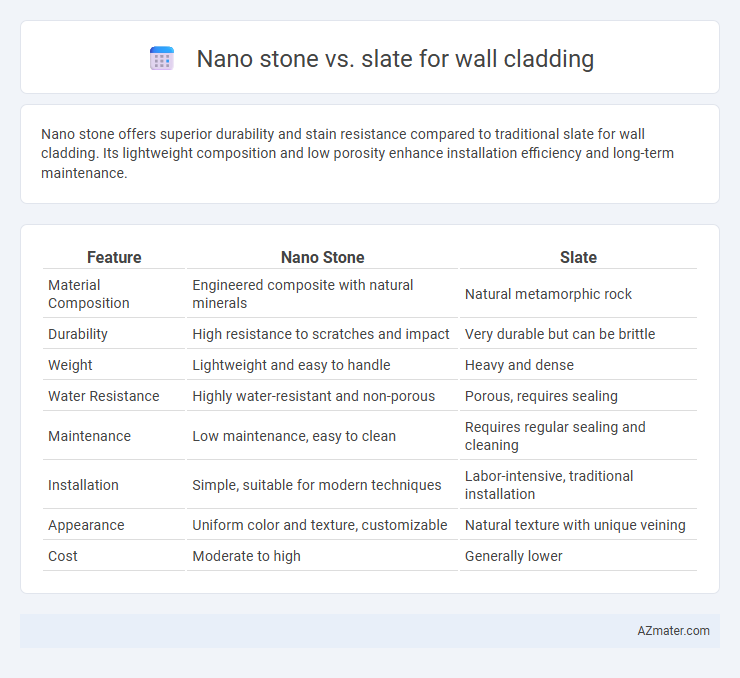Nano stone offers superior durability and stain resistance compared to traditional slate for wall cladding. Its lightweight composition and low porosity enhance installation efficiency and long-term maintenance.
Table of Comparison
| Feature | Nano Stone | Slate |
|---|---|---|
| Material Composition | Engineered composite with natural minerals | Natural metamorphic rock |
| Durability | High resistance to scratches and impact | Very durable but can be brittle |
| Weight | Lightweight and easy to handle | Heavy and dense |
| Water Resistance | Highly water-resistant and non-porous | Porous, requires sealing |
| Maintenance | Low maintenance, easy to clean | Requires regular sealing and cleaning |
| Installation | Simple, suitable for modern techniques | Labor-intensive, traditional installation |
| Appearance | Uniform color and texture, customizable | Natural texture with unique veining |
| Cost | Moderate to high | Generally lower |
Introduction to Wall Cladding Materials
Nano stone and slate are popular choices for wall cladding materials, valued for their durability and aesthetic appeal. Nano stone offers a lightweight, low-porosity surface with resistance to scratches and stains, making it ideal for modern architectural designs. Slate provides a natural, textured look with excellent weather resistance and thermal insulation properties, often preferred in traditional or rustic settings.
What is Nano Stone?
Nano stone is an advanced engineered material designed for wall cladding, composed of natural minerals and resin combined through nanotechnology to create thin, lightweight, and highly durable panels. It offers superior resistance to scratches, stains, and UV rays compared to traditional slate, making it ideal for both interior and exterior applications. Nano stone's consistency in color and texture provides a modern and sleek finish, whereas slate is a natural stone prone to variations and requires more maintenance.
What is Slate?
Slate is a fine-grained, metamorphic rock known for its durability and natural cleft surface, making it an ideal material for wall cladding in both interior and exterior applications. It offers excellent resistance to weathering, moisture, and temperature changes, which enhances the longevity of architectural surfaces. Compared to nano stone, slate provides a more natural and textured appearance while maintaining robust structural integrity for long-term use.
Aesthetic Differences: Nano Stone vs Slate
Nano stone offers a sleek, contemporary appearance with a smooth, uniform surface and vibrant color options that enhance modern interior designs. Slate provides a natural, rustic aesthetic characterized by its textured layers, earthy tones, and organic variations, creating a timeless ambiance. The choice between nano stone and slate depends on whether a polished, refined look or a rugged, natural feel is desired for wall cladding.
Durability and Longevity Comparison
Nano stone exhibits superior durability due to its dense, non-porous surface that resists weathering, stains, and scratches better than traditional slate. Slate, while naturally robust and weather-resistant, can be prone to chipping and requires regular maintenance to prevent erosion over time. The longevity of nano stone typically surpasses slate in harsh environments, maintaining structural integrity and appearance with minimal upkeep.
Installation Process: Nano Stone vs Slate
Nano stone wall cladding offers a straightforward installation process due to its lightweight panels and precise manufacturing, allowing for quick adhesion to surfaces with minimal preparation. Slate requires more labor-intensive installation involving heavy, irregularly shaped tiles that necessitate skilled masonry work, cutting, and careful alignment to ensure durability and aesthetic appeal. Choosing nano stone reduces installation time and labor costs, while slate provides a more traditional, robust finish but demands greater expertise and effort.
Maintenance and Cleaning Requirements
Nano stone offers superior resistance to stains and scratches, requiring minimal maintenance with only periodic wiping using non-abrasive cleaners. Slate, while durable and natural-looking, demands more frequent sealing and careful cleaning to prevent moisture absorption and surface damage. Both materials benefit from regular dusting, but nano stone's high-density composition provides enhanced ease of cleaning and longevity for wall cladding applications.
Cost Analysis: Nano Stone vs Slate
Nano stone offers a cost-effective alternative to slate for wall cladding, with prices typically ranging from $15 to $30 per square foot compared to slate's $25 to $45 per square foot. Installation costs for nano stone are generally lower due to its lighter weight and easier handling, reducing labor expenses by up to 20%. Maintenance costs are also less for nano stone, as it is more resistant to chipping and requires less frequent sealing than natural slate.
Eco-Friendliness and Sustainability
Nano stone offers superior eco-friendliness compared to slate due to its manufacturing process, which typically involves less quarrying and lower energy consumption, reducing environmental impact. Slate, while natural and durable, requires extensive mining that can lead to habitat disruption and higher carbon emissions. Choosing nano stone promotes sustainability by minimizing resource extraction and providing longer-lasting, recyclable wall cladding options.
Choosing the Best Material for Your Wall Cladding
Nano stone offers superior durability, lightweight properties, and resistance to scratches and stains compared to traditional slate, making it ideal for modern wall cladding applications. Slate provides a natural, textured appearance with excellent weather resistance and longevity, favored for rustic or classic designs. When choosing the best material for wall cladding, consider factors such as maintenance requirements, aesthetic preferences, and environmental exposure to ensure optimal performance and visual appeal.

Infographic: Nano stone vs Slate for Wall Cladding
 azmater.com
azmater.com